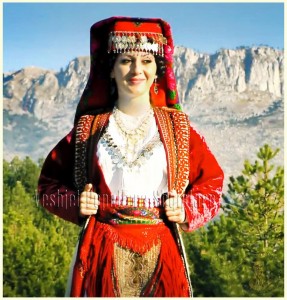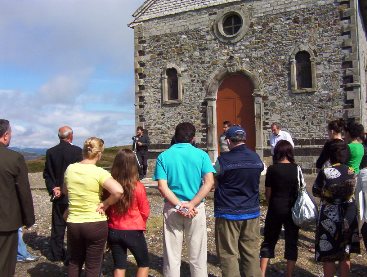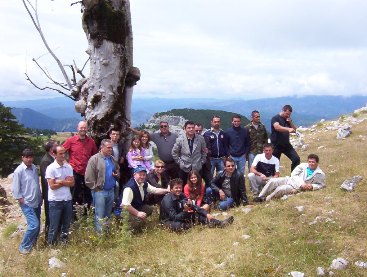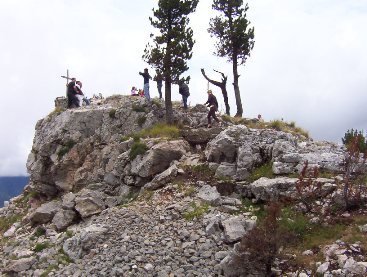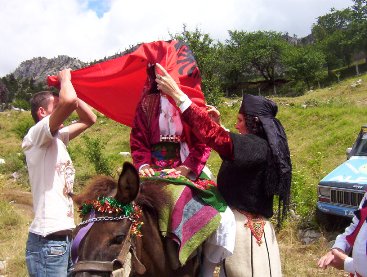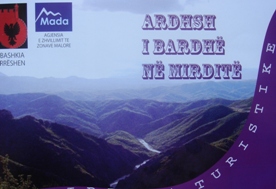 Agency for the Development of Mountainous Areas
Agency for the Development of Mountainous Areas
AN EXCURSION IN THE MOUNTAINOUS REALM OF MIRDITA
Many foreign and Albanian authors are attracted to Mirdita with their writings and studies, because they have noticed there “a strange world” that deserves the attention of scholars and observers from all of Europe. The drama of human grief, bitter luck, whimsy, the thrilling dilemmas for the conveyance of Self, the Kanun and Catholic religion are played continuously in the epic theatre of her crests. “Bad to live and worse to die”, says a Mirdita proverb, that makes you think about the well-known philosophic verse of Shakespeare “To be or not to be”. Mirdita, this ancient region, maybe with the most beautiful name in the Albanian world, represents a characteristic realm with a rare archaeological, ethnographical, lingual, folkloric and cultural tradition in the cultural map of Albania, dating from the ancient Illyrian times. The name of the region is first seen in the Ottoman registers of Sanxhak of Dukagjin in the period 1533-1536. According to the data, the first mention of the name “Mirdita” was made in Orosh. Here resided the leaders of the region and the Abbacy. In the 19th century and in the beginning of the 20th century, Mirdita is represented as the geographic union of 12 units, each one with a name defined boundaries. These were called the 12 bayraks (districts) of Mirdita. Mirdita was the most distinctive region for the protection and functioning of traditional rights under the Kanun of Leka. This code lived until our times because it played several vital functions in the country communities in these highlands. Under the conditions of foreign conquests it was an instrument of insurance for Mirdita’s autonomy and integrity. The region has a surface of 867 km2 and a border length of 178 km. As an ethnologic region it occupies a surface of 1,630 hectares.
The Mirdita area is mentioned as the country of Illyrians and Pirusts. Archaeological discoveries show that inhabitants were here since the Stone Age (4500-2500 B.C). In 1600 there were 3,300 homes with about 25,000 inhabitants. The highest population was reached in 1995 with 54,631 inhabitants, decreasing to 35,000 today because of demographic migration.
Geographers and historians put Pirusts in the Ethnologic Mirdita and also in the Middle Mat region. Their territory was hilly, mountainous and rich in minerals. These inhabitants utilized the natural wealth, which would have been mostly on or near the surface, and began the mastery of manufacturing metals, copper, silver, etc. There is evidence for the existence of early mines and also of crafts manufacturing industries for smelting, smithy, etc. The Roman Emperor, Trajani, transferred many of the Pirusts to Transylvania for the manufacturing of gold. Roman attacks on the Pirusts tribe in 12 A.D badly defeated them, and the population decreased. The region was repopulated in later times because of natural increase and from the migration of people other territories. The institution of administrative units instead of tribal ones led to the limitation of the Pirust’s territory, under the new geographic name Nderfane. This occurred at probably the same time with the changing of the name for current Albania from Ilir to Arber.
Approaching the border of Mirdita, an arched bridge, known as the Bridge of Zog seems like an entrance gate. Built in 1927, during the period of King Ahmet Zog’s reign, it is doubtless one of the most special bridges in the Albanian road infrastructure. As one of the biggest and most sophisticated structures built in the period since the 1930s, the bridge was designed by the Italian engineer, Martini, who had a building enterprise with the same name. The bridge project was implemented by the Albanian engineer Gjovalin Gjadri from Puka, who was known as the designer of the Milot-Burrel road that passes through Rubik, Fushe-Lumth, Kthelle, Livadhi i Turkut to Burrel, the birthplace of King Zog. The bridge has a length of 585 meters, a width of 5.6 meters with a space of 52 meters in between arches. It was the first in Balkans built with advanced methods, and the bridges of Mifol and Dragot were built with similar building techniques.
THE FRANCISCAN MONASTERY OF RUBIK OVER A WHITE CLIFF
Every traveler who comes through Milot passes through the monumental bridge with arcs, continuing through the Fan valley where the two rivers Fan and Mat join together. The Austrian writer Fabian Barcata, a well-known vicar of 900s called this valley “the most beautiful in the world”. At the entrance of Rubik, you can see over a white stone one of the monumental churches pg Albania, the Church of the Ascension (Shelbuemi).
See how Barcata describes it:
“…The Rubik cliff is very large; it looks like it is placed there by a giant in one of the most beautiful valleys of the world. It looks like the hand of a giant has flattened an area and has dispatched the mountains from one another to create a small valley with a crown of mountains around. In the middle of this valley is raised a colossal stone in solitude, with a magnificent view. Then came the people who saw that it was a beautiful place to live, and they established over the cliff their simple homes. They lived and died there above, generation after generation.
Located precisely over this white cliff of Rubik was a church complex with the church, vicarage and college, built with a rare architecture and with an inner graphic artistic demonstration (frescoes). These structures were reconstructed several times. The church complex was located on a natural balcony. This is a unique artistic work, a favorite tourist point and a special cultural monument. The scientist Gjecovi wrote his name in a stone under the church; there flew the muse of the writer Fishta, were written the pages of the historical diary of the priest Pal Dodaj. The Austrian parson, Franz Barcata wrote his notes in his diary there for ten years, while the unrepeatable works of the painter Leon Kabashi were created from his hands.
Taking in consideration the building style, the church belongs to the 13th century, 1272. The famous Shelbuemi Church of Rubik, documented since nine hundred years ago, was the temple of young brothers of Saint Francis, who is thought to have planted the pine that is known with his name in Lezhe in 1221. Frescoes have the traces of a great medieval art. The Judej Castle was located on the high crest of the white cliff.
Among the most valuable discoveries–not only in Mirdita–is the Emblem of Arber, discovered in Geziq, in the ruins of the old church of Nderfane. The emblem represents an eagle with one head looking to the right. According to the data the emblem is the symbol of Dukagjin Leka. Together with the emblem was found an epigraphic inscription in the style of Nderfane Saint Premte. Documents first mention, who projected the foundation of the state at the end of the 12th century and ruled in Arberia for nine years. After him, his son Gjin has ruled Arberia for eight years and then Dimitri for another eight years. But where is the residency of the Arberia State? Evidence favors Nderfane. Here are mentioned the battles with Ottoman Empire and the ascendance of well-known families like Blinisht and Dukagjin. Benedictine monasteries of Shpal and Saint Llezhderit in Orosh, the Arberia emblem in Nderfane, provide evidence that the lords of these territories had this area as their epicenter.
ASSEMBLIES OF SHPAL
Assemblies were the institutions with which Shpal was identified. In 1608 the second convent of Dukagjin was held, where the leaders of Mirdita and other regions that made an arrangement to get out of the Turkish domination were called together. In Shpal existed and functioned “the Residency of Mirdita Parliament” and here were also held the meetings of the 12 bayraks with the people. It is worthy to mention several of the other later assemblies, like that of 1862, organized by Mirdita’s Abbot Gasper Krasniqi. In 1876 it was decided to begin the revolt against the Turks and demand the freedom of Prenge Bib Doda with his return to the land; in that time the Prince was only 18 years old. In 1880 was another assembly where it was decided to send fighters from Mirdita for the protection of Hoti, Gruda and Kelmend. Another assembly was on May 3, 1912 for the coordination of fighting against the Turks.
If we come back to the ancient history, roads are among the most ancient things built by man. Albania, thanks to a special position in Balkans since antiquity, is traversed by important road arteries, roads that have traversed fields, the coast line and valleys. They have served for thousands of years for mutual exchanges between the Adriatic and the East, but also as strategic military roads. According to the researcher Pal Nikolli, at the end of the 19th century there were 150 paved roads and about 84 wooden or stone bridges built over rivers and streams in our territory. A road that linked Mirdita with the sea began in Lezha and continued to the center of Mirdita in Orosh, but there is little historical information about this road. We know only of some data noted by P. Koroneli in a 1688 map published in Venice. In our times the Durres-Prishtine motorway traces parts of the old caravan passes. In the valley of Mirdita the motorway passes 26 bridges and the Thirre-Kalimash tunnel, which at 6 kilometers long is one of the longest in Balkans.
From historical documentation of the Mirdita Abbacy in Orosh had the names “San Alexandri Maior de Albania” and “Sancti Alexandri Diocezis Albania”. This old abbacy was burned and robbed several times by invaders. Considering the location of the three main churches of Mirdita, Orosh, Rubik and Nderfane, the researcher Aleksander Meksi goes further than the notion of an abbacy in the Mountain of the Saint. He concludes that the three churches clearly define the extension of the Catholic Bishopric of Arberia as the actual region of Mirdita. Considering the importance of the Orosh abbacy in this region, the bishopric residency of Arberia was located there. The judicial court of the abbacy was reconstructed later in 1888 by the well-known abbot from Mirdita, Prend Doci. During his 29 years in the high position of Abbot, this cleric and patriot promoted the values of Mirdita and created worship institutions in a European format. The church was demolished in 1967, destroying an incalculable value of antique, historic and cultural heritage.
Today this church has been beautifully rebuilt, while a modern cathedral with attributes of the early abbacy has been built in the center of Rreshen, and named “Jesus the Only Savior of the World”. The cathedral serves as the center of the Rreshen diocese, which offers pastoral services for Catholic worshippers of Mirdita, Peshkopi, Bulqiz and Mat.
BENEDICTINE MONASTERIES
In Mirdita, almost at the top of the Mountain of Saint, there is a rare tree called Ulti, which is thought to be more than 900 years old. Out of eleven of these trees planted by the Benedictines, two lived until seven or eight years ago, and only one still exists like an old sphinx. During medieval times various monastic orders were created, included the Benedictines, dedicated to Saint Benedict. They lived in monasteries together with their abbot. There they lived the liturgical life, worked and created. They have formed the foundations of the modern culture. In Mirdita they were located in the Mountain of Saint, in Shenpal, Nderfane and Rubik establishing their monasteries which are testimonials to antiquity and culture.
TOURIST RELIEF OF NENSHEJT
Miracles of nature and uncommon histories! These you can find only in Nenshejt, the village lapful of divine miracles. Composed in a perfect way, the church ensemble includes the old abbacy of Saint Llezhder, Church of Saint Gjergj, Church of Shengjin, Church of Shelbuemi, Church of Petku (to attire the dead), the summer residence of the abbot, etc. It is a scene full of grace and splendor, a rare city of Christianity. Nenshejt also includes the peak of Zepa (1987m), Fushat e Lugjeve, Cave of Ice, Lajthiza, pine and beech trees and cold fountains. At these heights the worshipper was closer to mystery, while in Orosh Abbot Doci built a residency of abbots in a European manner. Here in these summer mountain pastures, Miss Durham made an interesting written portrait of the Abbot Doci, defining him as an intelligent person and evaluating his work in building the school near the church. Still here in the village of 8 typical alpine bastions, of infinite paddocks and crystal clear cold water, the miracle is exhilarating. Everything can be done here, parachuting, car and horse races, winter skiing and other different sports such as climbing and spelunking.
MIRDITA TOUR 2008
July 25th 2008!
The valliant drivers of Rally Albania have given infinite emotions in a combined activity including the Mirdita Ensemble in a tourist excursion, Mirdita Tour 2008. At top speed, full of adrenaline, without thinking about the risk, they took their distinctive 4X4 vehicles along mountainous roads of Mirdita, from Rreshen to the top of Shelbuemi in Nenshejt. The improvisation of early weddings with old traditions of the area were the most beautiful attraction for the participants and many national and foreign visitors. This was an activity organized by the Rreshen Cultural Department with the support of the Mountain Areas Development Agency, aiming to promote the tourist resources of such hinterlands. Rally cars are a symbol of promotional excursions through the mountains Albania. But different from what they have done in other areas–this time in the mountains of Mirdita–they had as their guide the artistic ensemble of Mirdita, bringing a magic tourist spectacle.
MIRDITA TOUR 2008
First Stop: Geziqi
Many cars, including those of Rally Albania, representatives of the Mountain Areas Development Agency, leaders of Municipality, artists, authors, researchers, were accompanied by a police car and stopped at the Geziqi church. Here the researcher Ndue Dedaj talked about the epicenter of the Arberia state, highlighting the importance of this area not only for Mirdita, but for all of Albania. This is verified by the emblem of Arber found here, which is now in the National Historic Museum serving as a testimonial of our authenticity. Participants were greeted by the Mayor of Rreshen, Gjon Dedaj, who expressed this as the beginning of a beautiful road for the promotion of the tourist resources of our region. Shkelzim Marku, the Director of the Mountain Areas Development Agency, was impressed by the natural beauty of this region. He said that his agency will give priority to the promotion of the mountainous areas and the resources that they have.
Second Stop: Bridges of the Motorway
After a short stop in Shpal at the place of famous assemblies, the tourist caravan led by Rally Albania passed through some parts of the new motorway, observing the giant bridges in Reps. One kilometer away you can recognize the modern European standard of this trans-Balkan motorway.
Third Stop: Ulti Tree in Nenshejt
Then the tourist caravan passed through the villages of Orosh, Lgjini and Bulshari and further to Nenshejt (1,500 meters above sea level). The most beautiful view there was after the spreading of the mist from night rain, we could see a marvelous panorama of the abbacy and traces of the motorway. The tourist group visited the Ulti tree in Nenshejt, planted by Benedictine monks who came here from Rome 900 years ago. Though “old”, and in its last breaths, it is a miracle in itself because of its beautiful location at Qafe Shejt. The researcher Bardhok Pulaj in the role of a guideexplained the history and the church ensemble in this magical place. Because of its history and picturesque view, the early Benedictines, who had as their motto the phrase “pray and work”, planted these trees as the seeds of the faith. Many photos are taken there. The Director of the Forest Service, Lek Marndrea has declared that this mountain is a protected national park, and as a result some revitalization projects will be implemented. This is important because these projects will protect the forests from cutting and especially from fires in the summer. The green crown of Nenshejt was burned last summer because from forest fires.
Fourth Stop: Fushe Lugjet
Then there was a spontaneous show of the Rally Albania cars in Fushe-Lugje, where courageous drivers like Spartaku, Edi, Dori and Xhikja performed magnificent scenes at top speeds, speeding across the fields. The noise of the motors made the horses run through the infinite paddocks and piqued the shepherds who come here with their cattle to pass the summer in dairy farms. This is also a blessed place for the bees that buzzed in the fields. Rally drivers said that it was an incomparable place of Albania, while they did treacherous climbing to the top of the hills. Big dogs of the dairy farms accompanied them, barking with the “gallop” of rally cars.
Fifth Stop: Mirdita Wedding Traditions
Nenshejti is gathered together in a wedding, a traditional wedding like in the early times. At the yard of spacious two-story abode of Gjete Ndoj,welcomed “the wedding guests of the Mirdita Ensemble”. A perfect show in the ceremony was performed by the artists of the Ensemble with the veiled bride on a horse, best men, mother of the bride and others. All this was accompanied by natural foods, welcoming of the best men and presents for the bride, while the Ensemble performed traditional wedding songs. In that pleasant wedding environment the visitors tasted traditional drinks, distinguished by the wine and brandy of the traditional regional viniculture, and also the medicinal drinks created by the master in this field, Nikoll Pershqefa. Forty types of popular medicines taken from the mountains of Mirdita were presented there, as well as the natural traditional food. The food on the table in green yard of this bastion was domestic, including yogurt, cheese, milk, meat, butter, honey, etc.
Miss Bjeshka
Beautiful and very welcomed was the presentation of summer beauties. Accompanied with orchestral the women presented traditional clothes of Mirdita. With public voting Miss Bjeshka was selected for the guide “Tourist Mirdita 2008”. The winner was Alvarita Preci, a student of Tirana University, while the runner-up was Pranvera Ndoj, who had just graduated in journalism and performed in a perfect way the role of the traditional bride. For the winners, the wine producer Arberi gave contributions to support the promotion of the rare Mirdita beauties. With the rhythms of the song “si vendlindja jone nuk ka” (roughly, “there is no place like home”) this special tourist activity is closed, a special event among all activities organized in Albania. The group stopped at the famous abbacy of Orosh, where its history and the famous priest Prend Doci were discussed. The story of the Captain’s family was told and the final itinerary at Gryke Orosh. From here, the group returned to Rreshen to finish this northern excursion, in a region which holds an extraordinary value for domestic and foreign visitors.
By: Aleksander Ndoja, webmaster & journalist.
Written material:
Ndue Dedaj (Land of Cathedrals) Bardhok Pulaj (Knowledge About the Motherland)
Gjon Marku (Nderfana)
Editor: Gjergj Marku
Organizers:
Rreshen Department of Culture
Mirdita Palace of Culture
Forum for the Development of Mountainous Areas, Mirdita
Mirdita, July 2008
Foto:
